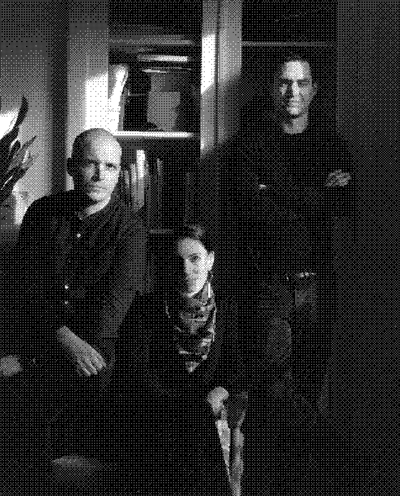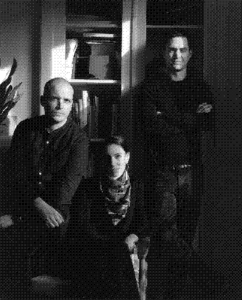Can you introduce yourselves?
My name is Liesbeth Abbenes, I studied at Rietveld Academy in Amsterdam, in the previous Audiovisual department – as it was called then. After this I did a postgraduate at Rijksakademie, a two-year education international program; it was called “Photography” but I studied in a more autonomous direction and started having my own studio. I made wall tapestry of textile, handmade. That’s around that time that I met Maurice; we were in the same building and we both had our studio. You could say that the start of our collaboration is when we first had a relationship and then we started to work together as we found a sort of equal interest in our working methods: being very precise and on the details. In my case, I was a bit more from the crafts side and more autonomous, as a fine art artist doing exhibitions at that time.
MS
I am Maurice Scheltens, I graduated in photography in the Hague and started with still‑life photography, as Liesbeth says, I was very much on the details too – that is also the reason we found each other and collaborated after our art schools.
Today we work mainly for magazines in fashion, design, and cultural institutes. We have always worked as a team, with a balance between two‑dimensional and three‑dimensional, graphic and photography…
LA
We have an interest for textures and for a kind of photography in which the tactility of materials is very vivid, very clear. Something to touch, almost. So we try to step out of photography sometimes.
MS
We wish we could paint (laugh).
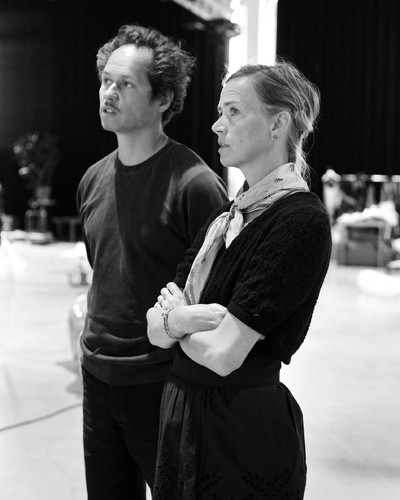
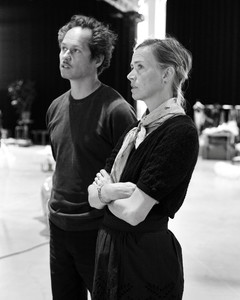
Maurice Scheltens & Liesbeth Abbenes
What is your state of mind right now, after one year of Covid. Did it bring changes to the way you work?
In a sense, our working method quite fits quarantine. (laugh)
We were very trained and used to working in solitude and with as little crew as possible. Of course sometimes we work with a crew, which is nice as well, but for concentration and the way we work it’s good to be in a small group. In that sense, it didn’t really change that much – besides the fact that we couldn’t see a lot of people and that we had to spend a lot of time homeschooling, which was quite a challenge. Talking about “assignment” … this was quite an assignment! (laugh). That made the daily rhythm a bit different, but we decided not to drive ourselves crazy trying to do everything in the same tempo, but instead, cut down the tempo a bit and include school in our days.
MS
Also, although we do still‑life, we work internationally, so we had to adapt: for example our agent was out of Paris with her kids because of the lockdown so this had an impact in the working rhythm of people. We saw very quickly that it was not really working out, especially during the first lockdown a year ago. But as the year before we had had quite a busy year with the exhibition at FOAM and the project at the Royal House, we decided …
LA
“Let’s make use of the situation and not get too stressed about it.”
MS
Nor too frustrated. We were lucky that in Holland you have quite a good financial back up system to help you, for instance to pay the employee we have at the studio, as we didn’t have projects for some time.
It was funny though, talking about adaptations to the lockdown; quite quickly we received two projects which were very …
LA
… interior.
MS
One for Flos, by the people of Apartamento Studio in Barcelona. They had a project called Together about being together, working or living, especially with the Covid period – working from your house, not being able to go out … They asked to send us some of their products for us to play around with them. We usually photograph products in our studio, but this was to be shot directly in our house, so it was a bit different and fitted quite well this feeling of being quarantined. We even made self‑portraits of ourselves which is not something we normally do. (laugh)
Another assignment came from Kvadrat, based on an idea we had had in mind for quite some time. It was also about people asking us: “As you live and work together in one place, how does your house look like? Is it as organised as your work looks?”.
So we put the camera in our living room and looked at how things are lined up. We pulled little blue ropes through the room, which were sorts of references to the Photoshop rulers you use to align everything – creating a kind of analog rulers and looking back to our house, wondering how it is really lined up.
LA
Bringing material inside through the lines, you get some kind of play with two and three dimensions. Sometimes you feel it’s flat, and because of the lines the room becomes flat. But then you see the lines are real and made of ropes: they are photographic and not graphic. This is a play that comes back in our work all the time.
It was a fun project; we created a metal frame on which we could tie the ropes and then line them up with the background. We were in the kitchen, standing up in the air, inspecting our house from very close … It was a kind of weird investigation with a millimetre accuracy of our own house, as if the walls would come up to you.
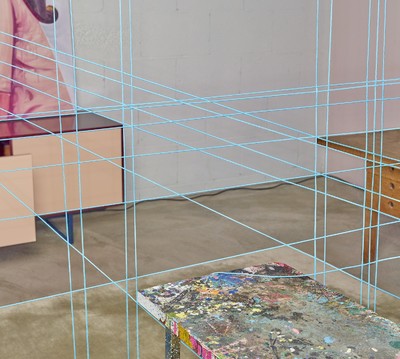

Kvadrat Interwoven, 2020
Overall, did you feel you had less requests and did you reorganise to deal with it?
It was very quiet until last June; we had some projects and you always have stuff to do, but home teaching in the morning made us quite unable to start a creative process afterwards. As we work but also have a family together, it’s not like I or Liesbeth can do pictures on our own; we do it together.
We thought immediately: “Let’s just first finish this and then we can continue”. Then things started again, and we got a lot of assignments between summer and Christmas.
LA
We also saw a lot of non‑profit projects, because nobody was having any money and everybody was insecure about what was coming … but still wanted to be visible. And of course it’s the same for us: we also like to stay visible.
Was your studio always in your house and what does it allow?
We have been living for seven years in this place, which is a studio connected to the house. Before that we use to have a studio in the city and live in North Amsterdam, across the river, so we had to travel up and down. But our dream had always been to have this together as we feel work and life is one thing. You do shut the door sometimes but there’s always something keeping going. It also allows us to show our kids how we work, what we do. And it was practically better to work at the house.
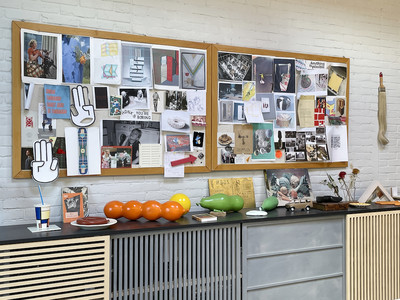

Scheltens & Abbenes’ studio wall in Amsterdam, NL
How would you describe living in Amsterdam compared to the other cities you have meetings and clients in, like New York and Paris?
In the beginning of our career we thought about moving to Paris or London – even New York was on our minds. It was just before internet – it was there, but not the way we use it today – and we were still running around with portfolios, travelling to London and Paris every month or two, so a lot.
But looking back, I think staying was a good decision. Amsterdam is a bit in the shadow of the big cities where the fashion industry or the design industries are, like Milan. We can work from the shade, being more free by having a sort of distance to this industry but also to our own work.
LA
So that you are not so swallowed inside and you can keep a fresh eye on it. You’re not in the hype itself.
MS
Of course we like this combination when we go to New York or Paris, as in Amsterdam there is this sort of saying: “Do normal” or “Stay normal”: it’s nice to take this energy from the big cities but we love to come back here. Although it’s the capital of the Netherlands, Amsterdam is like a village: it’s small and you do everything by bike.
LA
It’s also about the Dutch mentality, Calvinist from its origins, more discreet than what fashion is about.
MS
There is also a kind of quality‑standard of living here. Even if since the global AirBnB era, all the city sort of levelled up together and now the rents and mortgages are higher than before, it’s still more affordable than buying an apartment in London for example, or shopping there. Here we have a little boat we can take through the canals, the gardens … So we are very happy to have the best from both worlds. We live a bit outside of the centre of Amsterdam, like Brooklyn to Manhattan, so you have the space and with a seven minutes bike you’re in the city.
LA
Also as you grow older you may want to stay healthy. If you are always in a red race and only work like hell to pay the mortgage, it may not be an interesting place to be in the future.
MS
We already made a career but for young people it’s much harder today. We hired an intern, which we normally don’t do but it’s so complicated for them to get places right now, to get connections to build up their network, as there are no opening in galleries …
LA
A year is a long time for them. It’s terrible. I feel really sad for them.
MS
We are lucky to be in a good position: we didn’t see anyone getting very sick, we had some paid projects and nice editorial ones. We could do the schooling ourselves and we have a garden so we were there quite a lot and cannot complain.
What kind of creative references did you have in mind when you started?
We both had a background in connexion with textile but in different ways: Liesbeth with tapestry of course, but I also went to a fashion school before the art school. And we had an interest for graphic techniques. We both grew up with these elements and they merged and mixed.
LA
We also shared a way of thinking in solutions; wondering how you can achieve certain effects and how does it translate in the way you handle the set, for instance. We get enthusiastic about this kind of problems, we don’t try to avoid them. We have problem‑solving interests!
MS
We also ask ourselves the question: “What am I looking at?”.
When I started in school with applied photography – more than art, which is also part our balance as a duo – and assignments, I always felt clients should not underestimate the viewers and how they look into things … You should not make it too easy and too flat, because people are more intelligent than we can thought.
We are never that fond of marketing strategies or testing: we think there is a surprise element that should not be written. It is something which has always been on our minds.
LA
All this has to grow organically, as a process of concepts and examples that can make the clients believe in your vision, but still, you have to try it because you can think of a good idea that sounds great on paper but if it’s visually not translated, you have to change around and be flexible.


Fantastic Man, Blue Study, 2011 - Bally
As your work involves creative freedom, if too much information or instructions are given to you, it’s not a good tool to start. What is the best brief for you: concepts, pictures, descriptions?
For us what is always important is to be involved very early in the process. For example with Paco Rabanne; Julien (Dossena, Ed.) invited us at an early stage.
LA
They wanted to change around the strategy and style.
MS
So you can really start from zero.
We know, especially when you work with clients, that people have to present internally before – but sometimes it’s a bit of a pity when an art director comes up with images from other artists for example, or some materials and show them to the client. Especially if they are not creatives, it can be very hard for them to let it go. Even for us; if they show us a picture which may be a very good one that really explains the project, it’s very hard to get rid of it.
LA
We don’t want to copy anything … It has to come from your own ideas but sometimes, especially with fashion, it’s difficult.
MS
That also has to do with fashion being such a quick process. Every season you have to do new collections and new creatives, and photograph it. Now because of this Covid period, some designers are changing their perspective : they want to do one collection per year or two instead of four.
LA
Looking at the fastness of everything, you wonder: “Why?”. It’s only motivated by money of course, but we need to accept to want less than more; to keep the whole world healthy, and avoid clothes never worn, or even whole collections never sold.


Paco Rabanne campaign, 2016
How do you feel that you have an idea: is it a conceptual achievement, or an aesthetic satisfaction about the visual aspect of things – or the two are impossible to separate.
It’s a combination of all these things.
MS
We always think about an idea while talking or searching for references of course, in order to define which direction we want to take.
LA
But as we’ve been practicing for a long time now, we are trained and we quickly feel: “Now we have something that we can imagine a whole series about” or “We can present a product but also make an interesting picture without knowing what the whole assignment is about”. That is also something we keep in our minds: if there was no context, the picture would still need to stand up and speak for itself.
MS
Even when we are thinking about ideas from behind our desks, we always have to put the camera and the light on top of the object to see if it works, because it is a visible play that we do. Normally we use the first day of shoot to test our own idea, see if it’s strong, if it works, or if we need to change something to make it strong enough.
LA
Our brief is never too locked and we expect trust from the clients until a certain degree.
How do you balance between control and experimentation? Your pictures always look like fresh and playful experiments but is “failure an option” during the process?
In a way our work looks very organised and precise, but I think there’s also – although you wouldn’t say it directly – a lot of room for mistakes that we actually want to use.
LA
They are presents. Mistakes become presents.
MS
For example if you take a double‑take by accident. This technique could help tell your story, showing a movement for example.
Also, we don’t build very complicated sets. We wouldn’t build a whole cupboard to put things in for a shoot and then put it in front of the camera and think: “Oh it doesn’t work, but we’ve been building it the whole week, so we need to use it anyway”. That’s not how we work. Our sets and the lights we use, they’re quite simple and movable.
LA
It’s all an illusion in front of the camera. You don’t need to build everything as if it had to stand there for a long time. That’s what we make use of: an illusion of reality, that seems real but may not be. That is also a question that is inside our work: “What are we looking at?”. We also look for some sense of recognition from the viewer: as if you knew all these objects but never looked at them so closely. With photography, we try to bring back these memories of objects in people.
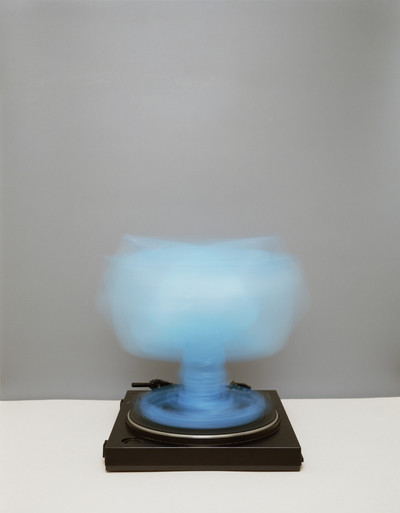

Hidden Objects, 2006 - Garbage Bag
How do you share roles on sets between the two of you?
I would say Liesbeth is normally …
LA
… the boss! (laugh)
MS
… the one who normally is making the objects, the sets, and I’m a bit more on the technical side: the camera, the lights. But every step we make is like a chess game. Liesbeth does something in the set, I put lights, then Liesbeth says: “Can you come closer with the camera?” then I add something to the object …
Still‑life is a very slow process. We do probably two to three images in a day – one if it’s a complicated set. Having our own studio allows us to leave the set there, sleep a night over, and look back at it the day after, and re‑shoot if necessary.

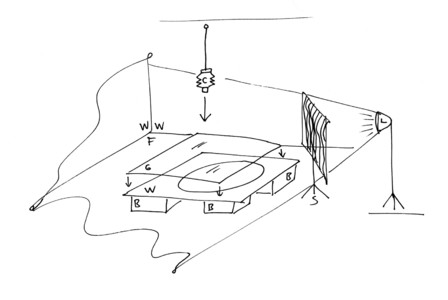
A set diagram by Scheltens & Abbenes
To include this process into pictures requires some time. Is it sometimes a struggle to get this time from the clients?
You have to keep explaining your method. Two weeks ago we shot a series for Fantastic Man and we asked for the clothing. We always ask to keep it for the whole week, which is almost impossible – sometimes you get it in the morning and you have to send it back in the evening – but we still ask. It allow us more freedom to play with it. Sometimes you make a shot the first day and the shooting evolves and on the last day you may want to re‑shoot the first two ones to get everything in balance again. It’s like sculpture: it’s a process. It’s not like you finish a picture and it’s done. So we always ask for this time.
Last week we did a project with Veronica from Gentlewoman for Hermès and they shipped it on Friday. We could unpack it and look at it in the weekend and start on Monday with testings. We shoot it Tuesday, Wednesday, and Thursday. We had the whole week … That’s the ideal.
LA
In general fashion goes very fast and sometimes it gets shallow because of this speed. You need time for things.
MS
But people do understand the way we work and do their best to adapt.
LA
Maybe we are kind of lucky that we do still‑life and not fashion with models because that’s all moving and quick, and you have people running in and out!
Do you only accept projects when you feel you have an idea or sometimes accept them and wait for the idea to come up?
For every project we ask ourselves: “Does the client fits us, or do we fit the client?” and “Can we add something to what they have in mind?”
When we’re not sure, we make a concept, send it over, and see the feedback. If it says: “Maybe we can stick to the other one”, we know we should not work together, because it means we cannot help each other. It’s not a way of being arrogant but it’s more that you want to make something…
LA
… that feels like you really are the one that should make it. And sometimes it should be someone else.
Sometimes in the first place we think: “maybe not” but if time allows to think a little longer we might come up with something good. Every assignment is a possibility. It’s not so often that you feel: “This is really not for us”. The object you are working on doesn’t make a difference, it’s much more about having a good idea and getting into it, and also having a client who is open for suggestions. Maybe that’s the only reason why you would say no: if you feel they expect something very different, then in this case you have to be honest.
When do you decide to involve other people on set, like set designers, builders or other artists?
The same way we think the best way to work is to be involved early in the process, we also know quite early if we need Stef Bakker (set designer, Ed.) or Anything is Possible (makers & set builders, Ed.), for instance.
Nowadays, when we get assignments, we usually see straight away if it is something we can do with one of these companies. We advise them at an early stage to be able to develop the idea together. We don’t make something in our mind and then say: “Can you make this?” because we know they have skills we don’t have.
LA
You need time for them to make something better. Time helps making an idea fuller. Making decisions only based on time is a pity.
MS
But on the other hand, for us it is important to work in a small team so you can keep the ideas clear. The more people are involved, the more there’s the risk of “noise”. With Anything is Possible or Stef though, we’ve been working with them for such a long time that it feels like we’re part of a team together. Same for our retouchers: I just send the picture and he knows what to do with it. We don’t have to tell him anymore.
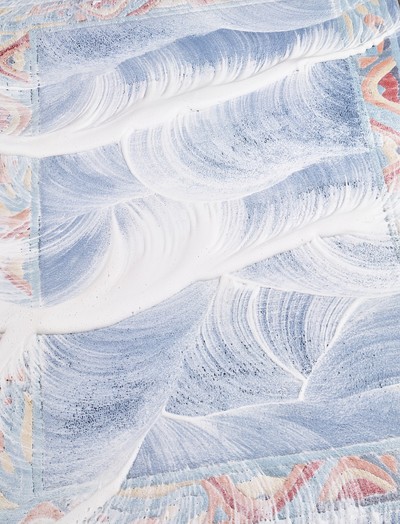

MacGuffin, The Rug, 2021
Would you say having had too many people involved is the main reason you might feel less connection with some of your pictures than with others afterwards?
When you look back on series that you might not like that much, it’s always related to having put too much water in your wine and not feeling the connection with what you were making anymore. And if you don’t understand what you’re making, in fact you may be just somebody else’s puppet.
MS
For the same reason it is also important that people coming over to the shoot are really in charge of the project. It doesn’t work if the shoot has to pause for someone to receive the pictures elsewhere.
LA
If there are a lot of captains on the ship, especially people coming from different departments at the client’s, like sales – who might be deciding in the end – they may have different expectations for the pictures. Opinions can differ on how the audience will receive a product. We always try to fight for our convictions but we can’t always win.
As we grow older, we get more experienced thus we feel at an earliest stage if we can collaborate or not, or we dare to say no more often. When you’re young, you want to give everything a chance – now this feeling is less present: you don’t need to prove yourself all the time.
When we teach students, we always advise them to be quite straight from the start in what they choose to do. It will get out and thereby it will be stuff you we’ll be asked for. You may be trapped if you want to be part of everything, it gets fussy.
Your agents play a role in the projects you receive. How did you chose them and how do you work with them?
We don’t have an agent in New York anymore because they stopped the company.
But we used to have an agent in the Netherlands from when we graduated until 2002. We were going a lot to Paris and London, so we looked for agents and ended up with Katy Barker who was our number one favourite. The company didn’t last long but the people who were working in the branches in London, New York, and Paris decided to continue to do the production. But not all of them kept standing …
We always feel that with Ingrid Janowski in Paris for example, we have such a good relationship: we trust each other. We like that it’s a small company and that she understands that we say no quite a lot, as I can imagine a lot of agents would not accept it. But it is also important to say no because it makes you stronger.
LA
She is thinking along with us on the kind of line we want to follow and she looks for the right clients so we really collaborate. It’s not just about – neither for her or for us – earning money but it is about doing something satisfactory.


Trailer, 2016 - #1 Pink Tulip
Do you sometimes look for meetings, opportunities, clients, yourselves, or only take incoming requests now?
It’s a combination.
Two weeks ago, I was in contact with our agent wondering if we should look for some art directors or people we want to send our book Zeen to. I remember talking about a specific brand, and then a project from them came up. It is nice that when you think about it new projects come up like it’s in the air in a way.
LA
We also recently did something for PIN-UP magazine that was more active from our side: we made a series and presented it to them, asking them if they would be interested to show it: that way we turned the usual process around and proposed ourselves.
Art directors and designers often don’t have agents, but photographers almost always have. When you started, did you think it was a sine qua non condition for you to work, maybe because you were based in Amsterdam?
Although it changes because now you have agents who represent art directors and creative directors, but it’s usually when they are more high‑level.
I think historically, photography has more to do with travelling so you needed somebody abroad. Graphic design has always been much more connected to local industries.
Of course, now the working methods with fashion and designers are more global.
LA
You don’t have to live where you work anymore.
MS
There is a sort of change, especially this last year: galleries are closed but everybody is still selling work. Yesterday, our framer told me they were busier than ever, not because of the museums but because private persons are buying works.
LA
There’s a lot of people buying art. Maybe it’s because no one can go on holidays so they have some savings left … And they are in their house more often, so they want to look at something interesting.
You accept projects or you don’t, but is it part of something you think of as a “strategy”?
A strategy is not a guarantee of success…
MS
… Sometimes producing work is the best thing to do!
And there’s also the surprise which comes by working day by day, which is something you should embrace. For us for example, we work in applied photography also because sometimes we receive questions we would not come up with if we were just doing our work as artists. So there are things that surprise us and are nice to make use of.
LA
Maybe that’s the strategy!
MS
Talking about strategy, I think there always has to be a sort of balance between being autonomous and applied. Sometimes you have a year where you work on a lot for art projects and you think you might want to do a bit more fashion, or industrial design, etc.
LA
And at the same time, then when something comes up which is nothing like what you planned, then your whole strategy is gone. Like in life itself, there are a lot of surprises. I mean, having a family as well, just from a mother point of view: there is so much we are not managing ourselves that comes in because that’s what life brings. If we had a strategy, then should everything else disappear for that reason? We are also lived by life itself, so I don’t really believe in strategies. It is a bit too formal. It’s another kind of world that talks about strategies and targets…
MS
When a company has more layers you have to explain yourself to other people in the layer system and that’s not what we are – even if now, we have people working for us: one employee and one intern, so of course we need to be clearer and tell what to do even if we work very much day by day.

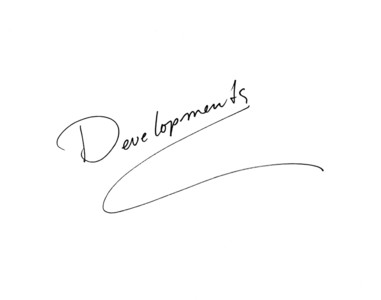
Do you worry at all about being influential?
Stay ahead! (laugh)
MS
We always try to turn negative things into positive. Because of the internet, there is so much imagery around that you don’t even talk about the word “copyright” anymore …
LA
Well you can talk about it but …
MS
There’s so much influences, references, and that’s OK. We are used to having people copying us, literally piece by piece, but most of the time this work we did was already made like half a year ago, minimum. We are much further then, so we just make new work and find new directions. Just stay ahead.
You said you felt concerned about your role as members of society, not only as artists. Is it something that goes into you work, are there any other fields even outside of creative ones that inspire you?
A lot of worlds can feed our interest in making something out of them again.
MS
What we are most inspired with is people making things, and it doesn’t matter what it is: it can be the person who is building a house, or the one who is weaving textile at the weavery …
LA
But it can also be subjects such as: how to save the planet, or health‑related issues …
MS
It is very much on a daily basis. If we do something for a fashion magazine like Fantastic Man it may not be fashion that inspires us but it could be that we are working in the garden and we look at our tools and think: “Oh these tools look great! We could do something like this for this fashion magazine”.
LA
It’s all quite visual. We get inspired through what we see. It may be less scientific but behind every object there is a science as well, so it’s related.
MS
Take beehives.
Yesterday I opened up the beehives again for the first time this year – I will have to do it in a few hours again – but it’s nice to meet somebody who’s doing these beehives on a project, so you see these beehives and their visual language attract you and then you start visiting the parks, make photographs, and then you end up having bees in your own garden! It is always a kind of circle.
LA
And also, back to the question of strategy: through our series we meet people and by meeting these people, we get new collaborations if it fits. Ideas are coming together. So you can never think about these things on a table: the pictures are also a motor in a way, they’re the engine for the road we take, the journey in meeting people.
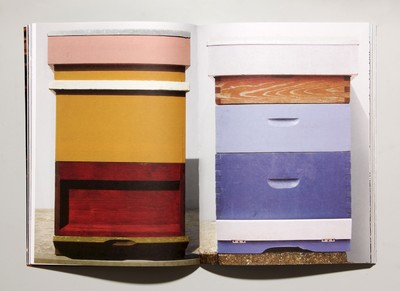
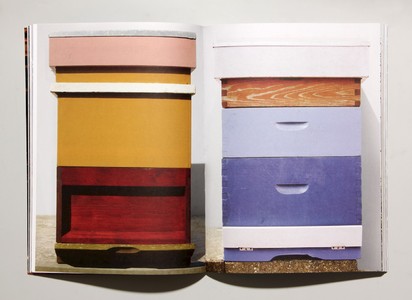
The Plant Journal, Beehives, 2017
Would you have an advice to give to your 20‑years‑younger selves, when you started?
“Don’t bother with what other people think!” I remember when I was young, I was being disturbed about what other people thought or the way it could make me insecure, which is typical of that age. As time goes by, you have less interest in what other people think and that provides you a feeling of freedom. Unfortunately, to get there you have to get older. (laugh) Maybe it’s not really an advice because it is something that you have to go through.
MS
Another one we always say to students is: “make things”. Its not about making a lot but in the end we feel that you should not talk and think and write too much about it – at least in our approach, and of course everybody has their own approach – but that you can only talk about your work when you’ve made it and also get experience as you make it. I remember being young I thought you had to get a good concept and then you start photographing it. But it actually holds you a bit.
LA
Because that’s what art schools want. And I also think that because of internet and a lot of work on computers students might be too stuck to their computers. They cannot work with their hands anymore. But the whole motor function of their minds and hands needs practice. It has to be seen as a skill you learn with time. It’s kind of a sport, a training. I think it is underestimated, as if it had to be all in our minds and intelligence: but intelligence also comes from doing.
Do you sometimes miss things from where you were younger?
When I look back at when I was young, I see a sort of braveness you have at that age. You start things having no idea how they’ll end but you start them anyway because you have so much energy, and it’s nice.
I just read a book on puberty for my own daughter (laugh) to understand what happens and it is very clear that the way your mind works at that time allows you to have all of these great qualities that young artists can bring. Maybe as you grow older you lose a little bit of that. You have more practice but the whole energy part, the way you can be opportunistic helps in creativity. A lot of good work is made when you’re really young.
But I think in our case, the practice helped us a lot in the quality of our work.


Alla Carta, Coming of Age, 2021
If you could live and work in a different place and period of time and do something else, what do you think you could do?
I would do your job and you would do mine! (laugh) No, I think I would be more an object builder: I would apply for a job at Anything is Possible.
LA
We’re so realistic, we never thought about it! I think I feel good about where I am, although I wish people would be more tolerant and there would be space for each other’s beliefs. When we see these terrible news – even if terrible news has always been around … I hope that young people will live in a safe and clean world and I don’t think people see the problem enough. So that would be it: a clean world with less luxury and a bit of slowing down. But it is hard to turn the clock around.
Is there any specific book or piece of art that guided you through your life or career?
Our own book Zeen! (laugh)
MS
We normally don’t have these sort of favourite things … Right now we have issues with our daughter so we are reading books about puberty, and in a month it could be something else again. It changes all the time.
LA
I also like to read novels so it’s not a direct inspiration but somehow, somebody else inspires me. Like the way a character is looking at life – these are made‑up personalities, so it’s not for real, but it could be. I think we are both realistic so we are not thinking in terms of utopias or through big examples or inspirations for the future we would love to live in, dreams and ideas of it. We try to make dreams real in a kind of way.
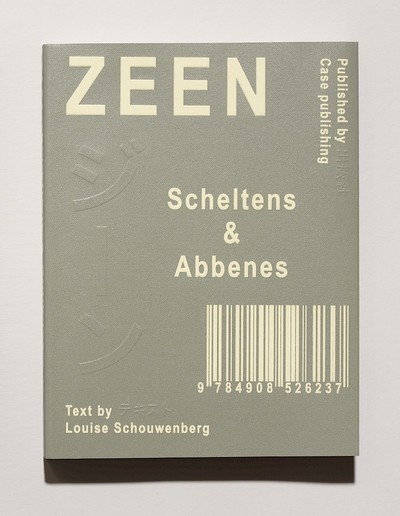

Zeen, Louise Schouwenberg, Case Publishing, 2019
What are you working on right now?
We just finished a very nice project for the Hermès magazine, which came out super good, we are very happy with it. It is about a colour library from silk samples which Hermès built up from the beginning until now I think. They sent it over, which is quite extraordinary as it’s an historical piece and they really still use it as a colour combination. It’s a practical thing, a low‑tech system that works as colour swatch. But they all look different, with some kind of text on it, so they have a kind of lived feeling.
MS
We have ongoing talks with museums for future projects.
LA
We did a series for Fantastic Man.
MS
A lot of projects will come out in two months, like the one for PIN-UP magazine. And we did this nice project for Profane: a series about the plastic sticks you use for coffee …
LA
… from somebody’s personal collection.
MS
It will come out any moment next month. We feel everything is starting up again now.
